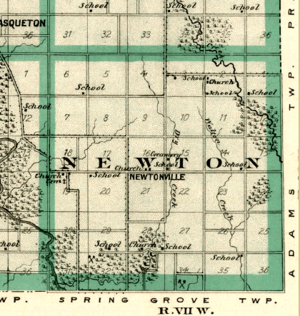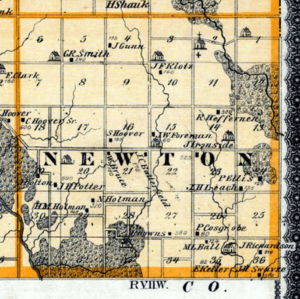Newton Township, Buchanan County, Iowa facts for kids
Quick facts for kids
Newton Township, Buchanan County
|
|
|---|---|
|
Township
|
|
 |
|
| Country | |
| State | |
| County | Buchanan |
| Area | |
| • Total | 36.33 sq mi (94.09 km2) |
| • Land | 36.26 sq mi (93.92 km2) |
| • Water | 0.06 sq mi (0.17 km2) |
| Elevation | 935 ft (285 m) |
| Population
(2000)
|
|
| • Total | 423 |
| • Density | 11.7/sq mi (4.5/km2) |
| FIPS code | 19-93096 |
| GNIS feature ID | 0468437 |
Newton Township is one of sixteen townships in Buchanan County, Iowa, United States. In the year 2000, about 423 people lived there.
Contents
Geography of Newton Township
Newton Township covers an area of about 36 square miles (94 square kilometers). It does not have any official towns or cities within its borders.
The small community of Monti is located in the northern part of the township. In the past, there were other small settlements, but they are now abandoned.
Newton Township has three cemeteries. They are called Circle Grove, Saint Patrick's, and Upper Spring Grove. Circle Grove Cemetery started in 1858. Upper Spring Grove Cemetery began in 1855.
History of Newton Township
The first permanent white settler in Newton Township was Joseph Austin. He built a cabin around 1847. It was near a spring and some trees.
The first election in the township happened in August 1854. Many of the early settlers in the area came from Ireland.
Early Settlements and Churches
Three cemeteries were started in the 1850s. In 1858, a Protestant church group began meeting in a schoolhouse. They built their own church building in 1884. It was next to the Circle Grove Cemetery. This church was known as Hoover Church.
A Catholic church and a rectory (a house for a priest) were built in 1870. They were next to the northern cemetery.
Newtonville was founded in 1873. A post office was built there near the center of the township.
In 1875, a map of Iowa showed two churches, seven schools, and 19 houses in Newton Township. Just 11 years later, in 1886, another map showed much more. It displayed 137 houses, ten schools, three churches, and two post offices.
Growth of Small Communities
Many other small communities grew up in the township. These included Erin, Atlantic, and Monti. None of these places ever became official towns.
Atlantic was in the southern part of the township. Erin was in the eastern part. Monti was founded in 1885. It was located on Buffalo Creek in the northern part of the township. The Catholic church was also in Monti.
In 1902, mail delivery changed. Rural Free Delivery meant mail was delivered directly to homes. Because of this, the post offices in Newtonville and Monti closed. In 1902, Newtonville had 27 people.

The Railway Era
In 1911, the village of Kiene was founded. It was about 1.5 miles west of Monti. Kiene was created because a railway was planned to go through the area. It was named after Henry or Peter Kiene, who were leaders of the proposed railway.
The Chicago, Anamosa and Northern (CAN) Railway was built in 1912. It passed through both Kiene and Monti. Monti quickly became a busy little community. It had stores, a blacksmith shop, a bank, and a train stop. In 1902, Monti had 110 people. By 1920, it had 100.
The old Newtonville Congregational Church was moved to Kiene in June 1914. A new church was built in Newtonville. In 1914, Kiene had 25 residents. By 1924, its population was 17, and by 1940, it was only 8.
Decline and Today
After World War I, the number of people in the area started to go down. The CAN railroad was taken apart for scrap metal during World War II. The areas of Newtonville, Erin, and Atlantic became empty.
By 1955, only the church building was left in Kiene. The Kiene Congregational Church closed in 1970. Its members joined another church.
The school in Monti closed in 1966. Its school district was divided. Today, Monti is the only settlement left in Newton Township. You can still see parts of the old railroad track near Monti. St. Patrick's Catholic Church in Monti stopped having regular services in 2005.
Parks and Recreation
Newton Township has two special areas for nature and fun.
- Newton Township Wildlife Area: This park was created in 1998. It is 158 acres (about 0.6 square kilometers) big. It is located southeast of Monti. You can go canoeing, fishing, and hunting there.
- Frogville Access: This park was started in 1978. It is 116 acres (about 0.47 square kilometers) in size. It is in the southwestern part of the township.
See also
 In Spanish: Municipio de Newton (condado de Buchanan) para niños
In Spanish: Municipio de Newton (condado de Buchanan) para niños



